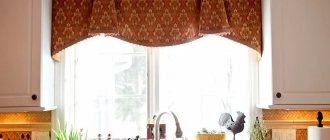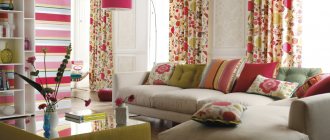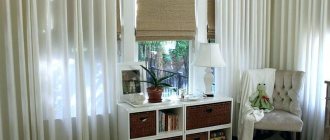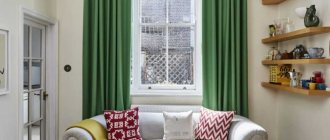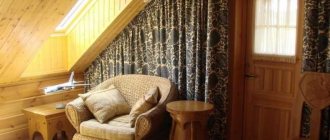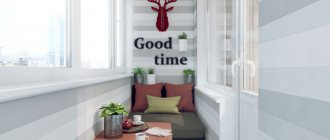If you are looking for how to decorate your windows in a way that is both practical and beautiful, pay attention to Japanese-style curtains. Let's talk about them in more detail.
Using Japanese-style curtains on windows Source dekormyhome.ru
Japanese-style panel curtains on floor-to-ceiling windows Source homeli.ru
How to decorate windows in a house with Japanese curtains Source berkem.ru
Light Japanese curtains decorate window openings in the house Source design-homes.ru
Japanese curtains (also called panel curtains) are flat, wide pieces of fabric or other material. At the top they move along a special narrow cornice, and at the bottom they are equipped with weights. That is, such curtains are similar in design to vertical blinds, but consist of fewer stripes, and each of them is much wider.
Interior with Japanese fabric curtains on the windows Source tekstilprofi.com
Basically, Japanese curtains are used for large floor-to-floor or almost floor-to-floor windows for their intended purpose - to protect from sunlight. In addition, they are convenient for blocking doorways and zoning space in any room of an apartment or house.
Window decor in the office using Japanese curtains Source design-homes.ru
Such curtains come from Japan, a country where minimalism dominates in architecture and interior design. Therefore, they are most suitable for simple, concise and modest design options. Of course, it is also possible to fit them into a room with a luxurious and sophisticated appearance, but it will be more difficult.
Japanese curtains made of bright fabric - the highlight of the interior Source olyta.ru
The design of all such curtains is the same, but the materials from which they are made may be different. In a classic Japanese interior, preference is given to natural materials, and not only fabrics, but also, for example, straw or bamboo. But this is only one of the options.
Curtains in the dining room Source profdekor.ru
Red option for the kitchen Source tkac.ru
Linen
Perhaps this is the most versatile type of Japanese-style curtains. They will fit into almost any interior. Linen goes well with both natural materials, such as stone and wood, and with artificial finishes, metal, plastic and the like.
Japanese style curtains made of natural linen fabric Source tapecariabrejao.com.br
See also: Catalog of companies that specialize in interior planning.
Made from rice paper
Such curtains will fit perfectly into Japanese or other minimalist oriental interiors. They are suitable for any room except the bedroom. This is because they protect from direct sunlight, but let in a lot of light.
Decorating the windows of the house with vertical curtains in the Japanese style with rice paper canvases Source brosko24.rf
Made from blackout fabric
Blackout is a special material that completely absorbs light and does not let it into the room. Curtains with it are best hung in the bedroom and in other rooms where you may need to achieve complete darkness even in the midst of a sunny day.
Panel curtains made of opaque blackout fabric in the bedroom interior Source berkem.ru
Satin
Such curtains are a practical and economical solution. Satin boasts an affordable price, long service life and a wide variety of colors. Along with linen, satin Japanese curtains are the easiest to fit into any interior design.
Silk
Natural silk is an expensive and luxurious fabric that, if chosen correctly, can literally transform the interior. Silk curtains are incredibly beautiful both in a single color solution and when decorated with ornaments or designs based on traditional oriental motifs.
But due to their beauty and sophistication, such curtains are not suitable for all rooms. For example, in a tiny loft-style bedroom they will definitely look alien. It is better to hang them in large spacious rooms with luxurious and “rich” interiors.
Bamboo
Bamboo curtains are easy to care for, durable and provide a high, although not complete, level of shading of the room. They harmonize well with interiors in Arabic and Asian oriental styles, eco-style, minimalism, contemporary and even loft. In a word, in all those designs that combine brevity and active use of natural materials.
Oriental home interior with Japanese curtains made of bamboo fibers Source dizainexpert.ru
From organza
Organza is a transparent fabric made from synthetic and natural fibers. Due to its transparency, it visually lightens the interior, making it more airy and weightless. But because of it, it does not protect from the sun in any way. Therefore, it is worth using such curtains either in combination with opaque ones, or in those rooms that do not need shading.
Plastic
Often the role of these curtains is not only and not so much functional as aesthetic. They are not just one of the many interior details, but an important stylistic accent. For this purpose, curtains are made in bright colors and provided with perforations.
An important nuance is that they use special plastic that is especially resistant to prolonged exposure to ultraviolet radiation. That is, you can be sure that your curtains will not fade or lose strength after just a month of use.
Convenient rope mechanism for controlling fabrics in Japanese curtains Source karniz-ekb.ru
Japanese curtains with a convenient electric drive for moving the curtains Source m-karniz.com
Types of control of curtain panels:
- Manual. It is convenient if there are several canvases and you rarely need to move them.
- On a cord or rod. Allows you to conveniently control the canvases without touching them.
- Automatic.
Nuances of arranging Japanese curtains
The birthplace of screen curtains is Japan. Initially, these sliding interior items were used to zone the room. Only later they began to be used for window decoration.
The photo of Japanese-style curtains shows that they are rectangular pieces of fabric up to 150 cm wide that can be moved along guides. If lightweight material is used, it is stretched onto the frame. When sewing panels made of heavy fabric, it will be enough to attach a weighting agent to the bottom.
Living room according to the principles of Feng Shui
Curtains in the living room simultaneously perform several tasks:
- protect from sunlight;
- decorate the interior;
- create the reputation of the house and its owners.
That is why, when choosing Japanese panel curtains for the living room, you should focus on the following tips:
- to visually expand the size of such a room, use products with horizontal stripes;
paneelgiant
godear_design
- to add coziness and homely warmth to an almost empty room, choose panel curtains decorated with a slightly “tacky”, maximally simplified print;
rachelh654
lerideau_sarl
godear_design
- to drape a small window, choose models consisting of two or three canvases;
paneelgiant
- to add status and emphasize material well-being, combine panel curtains with other textile items;
abdulhaqblinds
- to decorate the interior, according to the principles of Feng Shui, you need to choose blue, orange, green or crimson curtains (depending on specific tasks). So, for example, to improve your career, create an interior where blue and blue tones predominate;
pekmezboz
romari_home_design
godear_design
- To attract love into your home and improve mutual understanding between all family members, choose pink or white-pink curtain panels. Support such a bright color with pink-colored items and changes will not keep you waiting;
woodandwashi
romari_home_design
godear_design
- to cleanse your home of negative energy, use snow-white panel curtains of different textures;
contrejour_official
godear_design
- To improve the circulation of energy in your home, choose bamboo curtain panels. They are light and non-bulky, which means that such draperies do not attract anger and envy into the home;
bestpriceblinds
godear_design
- To develop your creativity and fulfill your dream of long-distance travel, purchase window draperies with images of distant countries and cities.
godear_design
pros
The Japanese curtain has a lot of advantages. The following advantages stand out most clearly:
- high quality of materials used;
- beautiful color schemes;
- absence of draperies and folds;
- ease of washing;
- variety of sizes;
- functionality.
It is also worth noting the uniqueness of the fastening system for Japanese curtains.
Panel management
The curtains can be adjusted with a cord or an automatic remote control. Five-row panels are best controlled with a stylish remote control.
Easy to make and functional, Japanese photo curtains in the interior will add an extraordinary airy atmosphere. This strict elegance of Eastern culture will appeal to many.
Material of manufacture
The design of these curtains is the same. However, the material used to sew them may differ. Below are the most popular options.
Pros and cons of zoning with curtains
The main advantages and disadvantages of interior curtain structures are highlighted.
| Advantages | Flaws |
| Unlike other types of zoning, this option is the most accessible and inexpensive. | Fabric sheets accumulate dust. |
| Curtain designs are characterized by quick and simple installation, which only includes installation of the cornice. | They contribute poorly to sound insulation, which cannot ensure comfortable rest and sleep. |
| They are very easy to use and do not take up much space. | Translucent models are translucent and therefore are not able to fully hide the separated space. |
| Thanks to the huge selection of models, they can be selected to suit any room interior. |
Organza
Such curtains allow you to visually relieve the atmosphere and make it more airy. Their main drawback is low sun protection. But it disappears if you complement the organza panels with canvases of opaque fabric.
What types of curtains should I use to divide a room?
Zoning the room involves the use of curtains of various types.
Blinds
Both vertical and horizontal models are perfect for dividing a room. Blinds are very convenient, they perfectly hide the separated area, and when assembled, such structures are almost invisible.
The photo shows horizontal blinds as a zoning option for a living room combined with a sleeping area.
Japanese curtains
Mobile panel curtains with their appearance resemble an interior partition and occupy a minimum of space. Japanese canvases, decorated with patterns or 3D drawings, make the interior of the room refined and original.
Filament curtains
Weightless curtains create an interesting optical effect in the room and do not weigh it down. Zoning with thread curtains made of beads looks very unusual and becomes a real decorative highlight of the entire interior.
Curtains (tulle)
Translucent curtains up to the ceiling are especially suitable for zoning a small room. They are able to adjust the space, add volume and a feeling of lightness to it.
Curtains
They should be double-sided to look beautiful on both sides. Thick curtains not only perform a decorative function, but also allow you to create a personal and more private space in the room.
Roller blinds
Roller blinds are suitable not only for functional zoning of a room, but are also an excellent camouflage option. Behind them you can hide anything: from a niche in the hallway or bathroom, to a shelving unit in the living room or a dressing room in the bedroom.
Mounting options and types of cornices
Curtain panels can be fastened:
- to the ceiling;
- to the floor;
- to Wall.
As for the cornice for Japanese curtains, it comes in different designs. Here are some of the most popular options:
- Tire. Such a cornice is represented by several rows of tires (up to 5 pieces). Curtains are attached to each of them. The upper part of the canvas is fixed with Velcro tape. A weighting agent is attached to the bottom edge of the panels.
- Tubular. Traditional option. Tubular cornices can be made of wood, metal, or plastic. Such designs involve attaching curtains to rings or fabric loops.
Interesting ideas in photographs
Japanese partition curtains resemble wardrobe doors and do not eat up a single extra centimeter of space. Alternating companion fabrics in a Japanese partition curtain enlivens the interior and visually raises the ceilings. In the photo examples, Japanese partition curtains are made of the same fabric as roller blinds on panoramic windows windows.
This technique helps to give the office interior a single, strict style. A Japanese curtain separates the children's and living area in a one-room apartment. Light partitions in the color of the walls merge with the interior, give it airiness and visually expand the room. Roman curtains and Japanese partitions, made from the same fabric, unite the interior and give it stylistic unity Double Japanese partitions ─ it is convenient and ergonomic. If desired, you can create a dense, impenetrable to view and airy, almost symbolic wall. With a status movable wall made of golden brocade with a floral pattern, dividing the room into sleeping and living areas, a studio apartment in the art deco style looks expensive and elegant. Smooth folds on the curtains soften the academic rigor of the clear, geometrically precise lines of Japanese panels. This combination always looks very harmonious Photo curtains as a partition always remain in trend and give the interior individuality Translucent screen panels imitating frosted glass can easily divide the living room into working and dining areas and also easily combine it into a single whole The minimalist style inherent in the Land of the Rising Sun is manifested in Japanese the curtains are very bright. Their potential is inexhaustible. Like everything aesthetic and functional, they are doomed to take their rightful place in modern interior design. And if fabric panels did not exist, it would be worth inventing them.
How to care for screen curtains
Caring for curtains in Japanese style depends on what material was used to sew them. Fabric panels can be placed in the washing machine.
In this case, you must strictly adhere to the instructions and set the delicate wash mode. Simply wipe the plastic product with a soapy sponge. To clean the bamboo structure, you will need a vacuum cleaner.
After Japanese curtains are cleaned or washed, they are immediately hung without waiting for them to dry completely so that they acquire a smoothed appearance.
A Japanese curtain in the interior opens up wide scope for design ideas. It does not clutter up the space, but on the contrary, adds novelty and originality to it. With it you can create a design in different colors and textures that will bring an atmosphere of comfort and coziness to the room.
Curtain panels on the balcony
Modern balconies, equipped with panoramic windows, are quite different from the modest small extensions that were made before. They are literally saturated with light and air, so most often such loggias are used as an additional dining area.
Japanese curtain panels
Where are Japanese panel curtains suitable and how to sew them yourself
Look
More details
Italian curtains
We decorate the living room, bedroom, kitchen and balcony. 160 photos
Look
More details
Roman curtains
How to decorate a balcony, living room and office with Roman blinds. 192 photos of different ideas
Look
More details
And if you decorate the large windows of such a balcony with comfortable panel curtains, then neither the scorching rays of the sun nor the light of street lamps will interfere with a quiet family dinner. And if you drape the exit to the balcony with exactly the same products, you will get a very interesting airy solution.
fidan_perde_gokturk
romari_home_design
In addition, to decorate a loggia or balcony, you can use the following options for Japanese panel curtains:
- short . Short products that vaguely resemble shutters are an ideal solution for small balcony windows;
trevorbmcgee
- mixed length . Another win-win option is to use panels of different lengths to design a long balcony block (a high door and a small window);
cortina.co.jp
highburydesign
- dense and thin . This classic combination of curtains (thick panels + thin curtain and vice versa) is rational to use if the balcony doors do not open forward, but are moved to the right or left;
latenda_bergamo
altex_studio
- placed freely . If the balcony door opens forward, then window draperies should not interfere with its movement. To do this, they are placed in such a way that they do not interfere with the exit and entrance to the loggia.
romari_home_design
Photos of curtains in Japanese style
Recommendations for using curtain partitions
For proper zoning with curtains, several nuances should be taken into account:
- For small rooms, it is better to choose partition curtains made of lighter materials in light colors. They will not overload the space and will visually make it wider.
- When using curtains made of thick and dark fabrics, you should pay attention to additional lighting in the separated area.
- When choosing curtains for a room that should be divided into only two zones, it is better to use plain fabrics or models with simple and uncomplicated patterns.
- If the room is made in pastel colors, you can choose designs in brighter shades for zoning.
We sew curtains ourselves
There's nothing complicated about it. Fabrics are presented in stores in a wide range. You can even find already cut canvases with traditional Japanese ornaments and subjects. The necessary accessories are sold at any hardware store.
Japanese curtains - we sew them ourselves:
- Calculate how much fabric you need, based on the fact that the average width of one panel is 60 cm. If you want them to overlap each other, add an additional 60 cm. Length - the distance from the cornice to the floor plus 10 cm on each side for allowances .
- Cut the fabric into strips of the required width, taking into account the side allowances (3-4 cm on each side). Make the seams on the sides first. If the fabric is thin, plastic or fiberglass strips are inserted into them to create a rigid frame. Additionally, seal the seams with non-woven fabric or Velcro tape, otherwise the edge will not be perfectly smooth. Iron thoroughly.
- There is a drawstring at the bottom to insert the weighting material, and Velcro at the top. Be sure to iron it before sewing. Carefully secure with pins or freehand stitches at the edge of the top cut and machine sew the seam. Fold it inside out and stitch it too.
- Iron the resulting fabric so that it does not sag anywhere and wrinkles do not form.
- Hang the curtains on the curtain rod and thread the weights into the drawstring.
Video gallery
Photo gallery
Functionality
A sliding panel can perform several functions at once: it can divide a single space, providing an atmosphere of some privacy without creating barriers, it can also create a special background, harmoniously highlight furniture or become a highlight in the interior.
Using a Japanese curtain, you can reduce or increase the amount of light coming in; in the photo we see light and heavier fabrics that transmit light differently. You can combine several textures and colors in one panel; by sliding and sliding the panel, you can partially or completely divide the space.
Panels can change direction and be positioned differently, allowing you to create a new look every time. The ceiling cornice can be extended throughout the entire room and the position of the panel can be changed as needed.
Measurement, Delivery, Installation, Warranty
Our designer will advise and choose together with you the most suitable curtain option, carry out professional measurements, and recommend curtain rods and the best mounting options. And our specialists will deliver and install the selected curtains on site. Before printing, we make sure to carry out color proofs and provide a quality fragment. And of course we give a guarantee!
You can find out more details on our website in the Japanese curtains section.
And if you have any questions, just call +7 or write to us [email protected] and our specialists will advise you.
